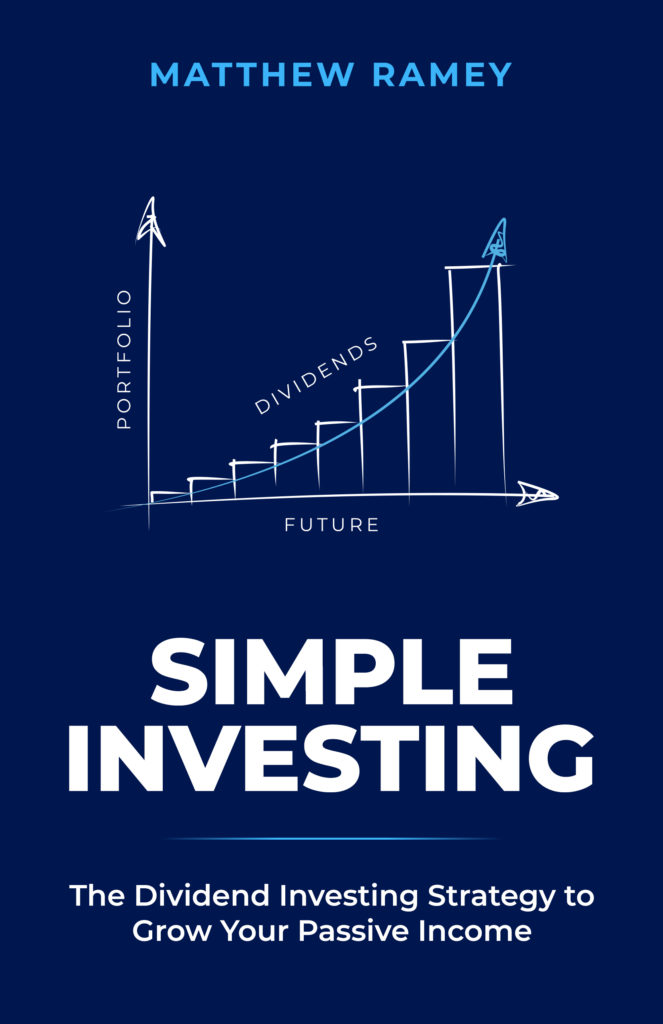3 Favorite Stocks From Money By Ramey’s Portfolio
Today, we welcome a guest post from SureDividend.com. Sure Dividend has some great insights on dividend investing stocks, which can help you build your very own dividend portfolio. Be sure to check out my portfolio as well as Dividend Income: the Trend.
The S&P 500 index is up nearly 18% over the last year, and has more than doubled over the last five years. The COVID-19 pandemic did negatively impact the market in 2020, but investors have seen strong gains even with the pandemic as a lingering challenge. Investors who held, or better yet bought, during the steep stock market decline last year are likely sitting on large gains.
For dividend growth investors, the focus should be on acquiring shares of companies that have increased dividends through multiple recession. This is why we favor high-quality dividend growth stocks such as the Dividend Aristocrats, a group of 65 stocks in the S&P 500 Index, with 25+ consecutive years of dividend increases.
This article will examine three companies that have experienced multiple recessions only to emerge stronger, and with a growing dividend.
Exxon Mobil (XOM)
Exxon Mobil is one of the largest energy companies in the world, with a size and scale that are nearly unmatched by peers in the industry. The company consists of an upstream, downstream and chemical segment.
The COVID-19 pandemic has weighed heavily on energy prices over the last year or so and companies in the sector have seen their top and bottom-lines crater. That said, OPEC+ production cuts should help stabilize the price of oil and allow it to reach pre-COVID-19 levels.
Exxon Mobil, like most energy giants, suffered greatly during the Great Recession. The company’s earnings-per-share initially rose in 2008 before suffering a steep decline the following. In total, the company saw its earnings-per-share decrease more than 45% from 2007 to 2009. However, Exxon Mobil rebounded the very next year and produced a 56% increase for earnings-per-share. The company hopes to see a similar turnaround in 2021.
Besides its massive size and global reach and diversified business model, Exxon Mobil does have quite a few positives going for it. First, despite the growth in demand for renewable energy, the company expects that the world will require a new supply of 550 billion barrels of oil and 2,100 trillion cubic feet of natural gas from now through the year 2040.
Exxon Mobil has invested heavily over the past few years in order to increase its production from 4 million barrels per day to 5 million barrels per day by 2025. This production growth remains intact despite recent cuts to capital expenditures.
Much of the production growth will come from several key projects. The Permian Basin, which has a projected 10 billion barrels of oil equivalent in the area, is expected to produce more than 1 million barrels per day by 2025, up from the company’s prior projection of 700K barrels per day. Exxon Mobil has also made some promising discoveries in the Guyana area, a site where multiple other oil companies drilled, but failed to find oil. Reserves now stand at almost 9 billion barrels in this area, up from 3.2 billion just two years ago.
Even better, management believes that 90% of new reserves have a production cost of ~$35 per barrel, making the company’s dividend safe at Brent prices above $45 per barrel.
This is news likely to be well received by dividend growth investors as Exxon Mobil would need to raise its dividend sometime this year in order to keep its growth streak of 38 years alive. Including the upcoming March 10th payment, Exxon Mobil has paid the same dividend for eight consecutive years. The stock currently offers a dividend yield of 6.8%.
We expect that Exxon Mobil will be able to grow earnings-per-share at a rate of 8% over the next five years due to the expected production growth and an eventual recovery from the COVID-19 pandemic. We do expect total returns to be pressured by multiple reversion. With a recent share price of $51 and using mid-cycle earnings-per-share of $3.26, Exxon Mobil trades with a price-to-earnings ratio of 15.6.
We feel that a 2026 price-to-earnings ratio target of 13 times earnings is fair takes into account both the tailwinds and headwinds the company is currently facing. Reverting to our target valuation would reduce annual returns by 3.6% per year over the next five years. In addition to 8% expected EPS growth and the 6.8% dividend yield, altogether we expect shares to return 11.2% annually through 2026.
Want to Learn Active/Passive Income and Investing Strategies?
Sign up for our Live Free and Div Hard email list to receive exclusive ideas and tips straight to your inbox!
General Dynamics (GD)
General Dynamics is a leading aerospace and defense company that consists of Aerospace, Combat Systems, Marine Systems and Technologies. General Dynamics’ top grossing platforms include the Columbia-class submarine, the M1 Abrams tank and Gulfstream business jets.
The company’s earnings-per-share actually increased 22% from 2007 to 2009, a noteworthy accomplishment given the circumstances of that time. Much of this is due to the company’s entrenched position as one of the largest suppliers of platforms to the U.S. Army, U.S. Navy and militaries around the globe.
Also providing a tailwind are the long-dated contracts that General Dynamics has in place with customers. Several products take multiple years to complete, which virtually assures they will be funded. And the company is often the lone or one of few providers for the platforms it produces. For example, there are just two companies that provide nuclear powered submarines and General Dynamics is the clear leader in this area.
In addition, General Dynamics often procures sustainment and modernization contracts on products once they are delivered, which allows the company generate additional revenue.
These factors have allowed General Dynamics to grow its dividend for 28 consecutive years. Shareholders have seen their annual dividend payments compound at a rate of 8.7% over the last decade. Despite this high rate of growth, the payout ratio has been below 40% for the entirety of this time. Shares yield 2.7% at the moment.
Given all the tailwinds to the company’s business, we expect that earnings-per-share will grow at a rate of 6% annually over the next five years. General Dynamics currently trades at ~$162 and is expected to earn $11.08 per share in 2021. This gives the stock a forward price-to-earnings ratio of 14.6, which is slightly above our 2026 target valuation of 14. Retreating to our target valuation would result in a minor headwind from valuation reversion.
In total, we expect that the stock will provide an annual return of ~8% per year over the next five years. General Dynamics is a high-quality business that has withstood multiple recessions while managing to raise its dividend distributions.
Johnson & Johnson (JNJ)
Johnson & Johnson is a diversified health care company that consists of a pharmaceuticals, medical devices and consumer products segment.
Johnson & Johnson has increased earnings-per-share at a rate of almost 5% annually over the last decade. This growth rate would have been higher if the COVID-19 pandemic hadn’t negatively impacted results for 2020.
Healthcare is often considered a recession proof industry and this appears to be correct for Johnson & Johnson. The company’s products are needed for patients suffering from various cancers and other diseases. Consumers also need access to the medical devices and consumer products needed to maintain or improve quality of life. As such, these products are often in demand even during a difficult economic period.
This leads to rather consistent revenue and earnings growth, which has allowed Johnson & Johnson to increase its annual dividend payments to shareholders for almost six decades. Shareholders have a received an average dividend increase of 6% since 2011. Johnson & Johnson sports a 2.4% dividend yield today.
Due to its consistent business model, we forecast an annual earnings-per-share growth rate of 6% through 2026. Shares of Johnson & Johnson currently trade at ~$167. With expected earnings-per-share of $9.50 for 2021, the stock has a price-to-earnings ratio of 17.8. We have recently raised our five-year target multiple to 17 times earnings, so there is the potential for moderate valuation reversion. Reverting to our target multiple by 2026 would reduce annual returns by 0.7% per year. Shares of Johnson & Johnson are expected to produce a total return of 7.7% annually through 2026.
Final Thoughts
Finding companies performing well during economic downturns is often a difficult endeavor, but we feel that companies with extremely long histories of dividend growth are an excellent starting point. Many of these companies, such as General Dynamics and Johnson & Johnson, have not only survived during the last recession they thrived. Both companies saw earnings-per-share growth during the 2007 to 2009 period as well as raised their dividends. Exxon Mobil did see a decline, but quickly returned to growth the very next year while also increasing its dividend at the same time.
For investors worried about the next downturn, companies such as Exxon Mobil, General Dynamics and Johnson & Johnson are high-quality dividend stocks to consider adding to their portfolios.
About the Author
This is a guest contribution by Nate Parsh of Sure Dividend. Sure Dividend helps investors find high quality dividend growth stocks to build their retirement portfolios. Nate is long JNJ and GD.
Books from MoneyByRamey

Budgeting is the vital first step towards Financial Freedom. Learn the ins and outs of budgeting with Simple Budgeting.

Investing is the vital first step towards Financial Freedom. Learn the ins and outs of investing with Simple Investing.
The MoneyByRamey Disclosure Statement
Disclosure: I am/We are long $AAPL $ADM $ALL $BG $BGS $BP $BUD $CALM $CAT $CAG $CL $CLX $CMI $COF $CSCO $DAL $DFS $F $FAST $GD $GE $GIS $GT $HBI $IBM $INGR $INTC $IRM $JNJ $JPM $KHC $KMB $KO $KSS $LHX $LUMN $MMM $MSFT $NWL $O $PEP $PFE $PG $SBUX $SJM $SPTN $STX $SYY $T $TSN $UL $UPS $WFC $WPC $WRK $WY $XOM
Disclaimer:(1) All the information above is not a recommendation for or against any investment vehicle or money management strategy. It should not be construed as advice and each individual that invests needs to take up any decision with the utmost care and diligence. Please seek the advice of a competent business professional before making any financial decision.
(2) This website may contain affiliate links. My goal is to continue to provide you free content and to do so, I may market affiliates from time-to-time. I would appreciate you supporting the sponsors of MoneyByRamey.com as they keep me in business!

